

Nursing Interventions: Implementing Patient Care Plans
To provide quality patient care over a period of time, nurses need a roadmap that guides their actions and quantifies desired outcomes. As a registered nurse, you will be responsible for creating a plan of care based on each patient’s needs and health goals. What is a nursing care plan? It’s a formal process that













